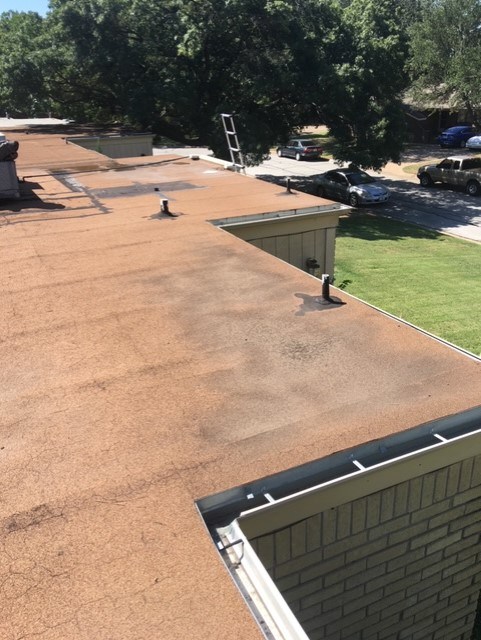Dangers of ponding water on your roof Frisco, Tx Coatings
Roofing materials are manufactured and roof systems are designed to shed water. They are not designed to hold water like a tank for some useful storage purpose.

When water is allowed to stand on a flat roof, one must suffer these consequences:
- In the event of a minor defect in construction or an accidental puncture, there is a reservoir of water to flow into the system. It may be stored in the insulation if an effective vapor barrier exists and the insulation is capable of holding water, or it may flow into the building interior some distance from where it entered the roof system.
- The combination of water and ultraviolet light can have a more damaging effect on most materials than either one alone.
- The slow evaporation of ponded water can leave concentrated solutions of chemical pollutants from the atmosphere por from the building itself. On a sloped roof such pollutants are washed away with each rainfall. If necessary, water sprinkling can be installed to provide cooling as well as cleaning.
- Ponded water is often responsible for the degradation of sheet-metal flashings and makes each flashed projection through the roof a potential leak.
- Each inch of water adds 5.2 lbs per square foot to the live load on the roof structure. Roofs have been discovered with up to 6 inches of water (31.20 lb) because of blocked drains. Some of these were discovered because the roof was leaking over the flashings. Others were found accidentally, and when the roof was cleared the force of water damaged the drainage system.
- The deeper the water becomes the greater the deflection is in the deck, which allows more water, and so on.
- Water on a roof encourages the growth of vegetation. Grass and small trees have been found with roots growing throughout the roof membrane into wood-fiber insulation.
- It is difficult to repair leaks in ponded roofs unless the water can be removed by pumping, syphoning, or by vacuum equipment, and the roof thoroughly dried. It is sometimes time consuming to locate a leak in a graveled roof when it is covered in water.
- Water on a roof in hot, dry areas may be considered to have some value as a coolant, a fire-protection device, and a buffer against wind damage, but its presence is usually accidental and cannot be relied on for such services. As a general rule, the disadvantages far outweigh the advantages.
- In cold climates roof water turns to ice when temperatures stay well below freezing. The formation of ice on the surface does no particular harm to a roof, but after it is covered with an insulating blanket of snow the heat loss from the building through an insulated system is enough to melt the ice and a blanket of snow. Even at subzero air temperatures, the temperature gradient is only 35 degrees to 45 degrees F. Under these conditions the roof and flashings would have to be perfect in every way.



